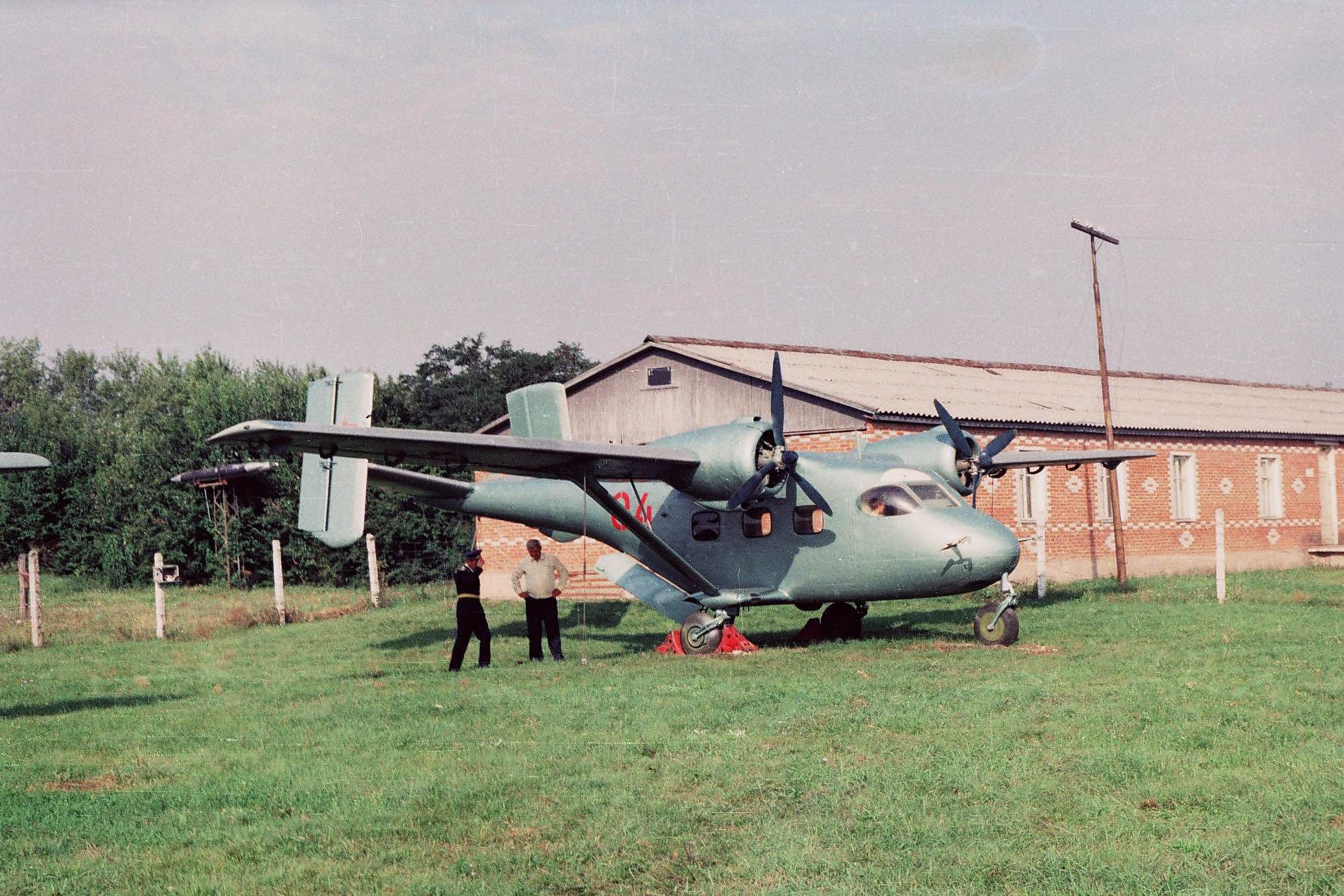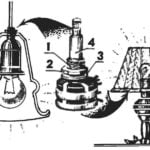 In the late 1950 O. K Antonov as chief designer of OKB-153, located in Novosibirsk, invited the leadership of the air force of the CAF and the draft aircraft short takeoff SLE-1. In the diagram of the machine catches the eye first of all, empennage mounted on two thin beams. Direct highly mechanized wing with flaps, drooping ailerons and an automatic end slats are two radial air-cooled engine AI-14R. It is through these engines takeoff power of 265 HP was able to put into practice the intentions of the designer.
In the late 1950 O. K Antonov as chief designer of OKB-153, located in Novosibirsk, invited the leadership of the air force of the CAF and the draft aircraft short takeoff SLE-1. In the diagram of the machine catches the eye first of all, empennage mounted on two thin beams. Direct highly mechanized wing with flaps, drooping ailerons and an automatic end slats are two radial air-cooled engine AI-14R. It is through these engines takeoff power of 265 HP was able to put into practice the intentions of the designer.
The project, according to experts, was all good. The aircraft could be used by the military as a messenger, for transportation of small cargoes, including ammunition, and to deliver a small assault. CAF but he was not satisfied, mainly because of the small load capacity and Seating capacity.
The team of OKB-473 (the name of Antonov design Bureau after moving to Kiev) quickly took into account the comments of the customers and in January of the following year suggested that SLE-2 machine with increased to 2356 kg takeoff weight. Feature SKV-2 was podesavanja under the wing of a cargo compartment (up to 600 kg in accelerated version), which if necessary can be replaced triple passenger (or other purposes).
Given that landing on “noses” the plane will perform with a greater vertical speed than the classical machine, the designers brought the course of the landing gear shock absorber up to 700 mm
The calculations showed that the landing speed SLE-2 will not exceed 55 km/h, and the length of run and run will be about 20 m. What is not a chopper?
Having considered the draft design of the SKV-2, the CAF, the Commission noted in particular that “adopted by the author of the straight wing with end slats has a tendency to sudden breakdown of flow in the Central part (…), in connection with the wing and aerodynamic configuration of the aircraft generally require elaboration and testing in the wind tunnel”. Then the customer demanded to increase the climb rate of the machine up to 5 m/s, and in case of failure of one engine it was supposed to be below 1 m/s at an altitude of 500 m. Given the need of the CAF in such aircraft, the customer wanted to further develop the project and build the prototype meets its requirements.
In may, 1956 issued a decree of the Council of Ministers on the establishment of the future An-14, design of which began under the leadership of Deputy chief designer Y. A. Belolipetskii. Project 1955 remained, perhaps, the idea of strut-braced wing, dvuhkilevoe plumage and a couple of motors.
According to the decree of the government of the An-14 with the engine M-14P had to carry 67 passengers at a speed of 170— 180 km/h at a distance of 600-650 km run and the mileage was not supposed to exceed 60 m and 80 m respectively. The same document instructed to present the aircraft on state tests in the fourth quarter of next year, and based on additional requirements of the CAF was asked by the construction of its sanitary (in 1959) and agricultural modifications. Combining both the latest version built aircraft registered under the symbol of the USSR-Л1053.
For easy loading of the wounded and bedridden patients in the fuselage (under tail boom) instead of a door made of a large cargo door and pilot door front windshield. For aerial work through the cargo hatch in the fuselage mounted tank for chemicals or fertilizers – the rest of the second prototype repeated its predecessor. It seems that the first two machines had insufficient directional stability that was the cause of the tail boom under the stabilizer of a small keel.
In the summer of 1957, the Commission considered the layout of the “Bees”, and March 14 next year at the Svyatoshino airfield in Kiev LEGIC test-LII, V. N.Isham tested in flight the first prototype An-14 with nine engines air cooling AI-14 takeoff power of 240 HP (hull number USSR—Л1958). First, the lead engineer on the car were Yu. M Kirzhner, then it was replaced by V. I. Linkevich.
Slats, double-slotted flaps and drooping ailerons did their job. The plane turned out robust and with excellent takeoff and landing characteristics, runway length does not exceed 60 m. For the entrance to a car of the pilot and 6-7 passengers served back door (by the way, allows you to parachute and parachute).
The first prototype was built as a demonstration. For the state trials produced the third prototype of the An-14A (USSR —Л5860). Retaining the layout of the fuselage of the first machine and the spent wing aircraft equipped with a new power unit with uprated AI-14RF and a two-bladed wooden screws В536-D12 with the mechanism of feathering and the new plumage, noted for the /-shaped and rectangular stabilizer stabilizer pitching washers is larger (as in the layout approved in August 1957). If the cause of the latest revision is quite clear, the emergence of a new stabilizer can be explained by the desire to protect the keels from impact with the ground on landing.
In April 1960 the Chairman GKAT P. V. Dementiev wrote to the defense Minister Rodion Malinowski:
“According to Your request, we examined the ability of highly reliable liaison aircraft. Chief designer of Antonov created light passenger aircraft An-14 with engines AI-14R.
Currently OKB-473 built three flight instance (…), which made 900 flights with the common touch 355 hours, with one of the aircraft flown 187 hours..
The prototype An-14 passed verification tests at the NII GVF results, ( … ), there is work underway to increase the vertical speed when flying on one engine. The aircraft with improved aerodynamic quality will be presented on state tests in October — November, 1960″
In the same year for the first time flew An-14A, piloted by pilot V. A. Kalinin. Factory testing, in General, confirmed the calculated data, and in January 1961 the third prototype in the passenger version, tried to pass the joint industry of the CAF state tests in NII VVS, However, customers demanded OKB-473 to conduct additional flight tests of the factory to check the number of parameters of the aircraft, powerplant and equipment. It took more than six months. Then customers demanded the state bench tests of engine AI-14RF with a service life of 500 hours.
However, to raise the guaranteed operating time of motors more than 150 hours then failed and in November at the airfield Chkalovsky (Moscow oblast) began public testing of the Leading machine were the engineers of the L. N. Falcons-Sokolenko (NII VVS) and R A. Teimurazov (GosNII GA), as well as military test pilots A. I. Borzov and A. S. Andreenko. The overflight was attended by sixteen test pilots. According to the opinion of aircraft flying qualities were quite simple and is available to pilots who flew the An-2, Yak-12 and trained for piloting in some special cases. Stability and control were largely satisfactory.


Multipurpose plane an-14:
1 — Aileron; 2 — propeller AV-14; 3 — step; 4 — air intake of the heat exchanger; 5— the hood motor M-14RF; 6 — exhaust pipe; 7 — antenna VHF-radio; 8 — antenna radio altimeter; 9 — slat; 10 — valve of the upper air duct; 11 — slit flap; 12—LDPE; 13 — wheel 700×250 mm; 14 — mount bracket to the Aileron; 15 Kil; 16 — rudder; 17 — a suspension bracket of the Elevator; 18 — cantilever beam; 19 — brace; 20 — landing light; 21—taxiway spotlight; 22 — the weight balancer Aileron; 23 — fold entrance door; 24 — handlebar height; 25 — linen-covered steering wheel; 26 — the instrument Board of the pilot; 28. the damper of the lower air channel; 29— fairing oil cooler; 30 — the air intake of the carburetor; 31 Torah; 32 — closet; 33 — built-in ladder. Section X and C is made in scale 1:25, all others — 1:50
The noise level in the cockpit at takeoff or the first nominal mode of operation of the engine was great, but the route was significantly reduced and does not irritate the pilot and passengers. The specified flight mode, in a relatively calm atmosphere was kept quite simple and does not tire the pilot. At the same time, strict observance of the course forced the pilot to frequently intervene in the management.
Was great effort on the wheel (20-35 kg) of the ailerons and rudder, especially on landing. The lack of anti-icing device on air screws reduced the safety of flight in icing conditions.
Contrary to expectation takeoff and landing performance was much worse as promised and recorded during factory test. So, the run and the mileage increased to 90 and 100 m, respectively.
In one of the publications of O. K. Antonov said on this occasion: “On the factory test, we first deduced the engines “maximum”, then released the brakes. On state tests, the opposite is true. And manual you can not break”.
Conditions safe to continue the takeoff in the event of failure of one of engines of the aircraft required open approaches to the runway. The continuation of the takeoff with the flaps, deflected to 20°, proved to be more dangerous than removed. Need the same runway length in this case was increased to 400 m.
On landing the same at the high alignment level (1.2—2 m) at the end of the incubation with a fully assumed the helm of the plane vigorously lowered the nose and with a large vertical speed roughly chlipala on three wheels. Correction of high alignment increase the engine rpm was not possible due to poor pickups. That is why length of run was 60 to 100 m. the Reason for this was, primarily, not the customer (as sometimes written), and half-cocked the engines.
To reduce run and run was recommended to increase the thrust-to-weight the car and use reverse screws. In the latter case, to expand the capabilities of the machine had expressed wishes to set it in winter on skis (by the way, stipulated by the project, and a wheeled chassis allowed landing on the ground with the strength of 3.5—4 kg/cm2), and to develop an amphibious variant.
Performance when landing by “parachuting” is not even defined.
In 1960, at the Svyatoshino airfield in Kiev, the An-14 was flown by test pilot NII VVS A. G. Solodovnikov. In his never published memoirs, he wrote: “the Bee” had a good takeoff and landing characteristics. Before planting, inherent only to this plane, a car was aged at a height of about one meter at high angles of attack and higher mode of operation of the motors. Then the engines were dresslerville, and the plane “chlipala” on the ground. Mileage only some 20 m. If it were not for the helicopters, the “Bee” could find wider application”.
State testing was completed in April 1962, and the act on the results, it was noted: “Given that the BBC and the CAF are interested in aircraft that support operations in neurogranin conditions for use in the communication, agricultural, passenger transport and sanitation options, to run An-14A in series production in the case of elimination of defects…”
“In the summer of 1961, wrote in one of the articles by O. Antonov, in the form of experience we have identified on map 68 of small settlements, without asking if there is a helicopter pad. And the pilots were asked to land in each of them not further than 200 — 300 m from the edge of the village. Three of the flight the pilot had been in all of the set points, choosing a site from the air, and fully accomplish the job.”
Another flight length of 10 627 km through 22 cities of the USSR was performed by test pilot V. A. Kalinin with journalists on Board, having made 53 landings, and a quarter of them on unprepared ground.
Since the issuance of recommendations on the deployment of serial production to built in Arsenyev first car, it took almost three years. Time for a small aircraft a lot, and it can be explained only by the serious modifications that required lengthy ground testing.
On serial An-14 significantly changed both the shape and the elongation (increased from 10.7 to 12.2) of the wing. Redid the nose of the fuselage, increasing the base chassis. Access cab and all loading and unloading operations, as before, was carried out through the rear hatch. In the first production of “the Bees”, and held pilot tests in NII VVS, preserved the old power unit, with two-bladed propellers, later replaced with a three-blade.
The plane launched at the plant “Progress” in Ulan-Ude in may of 1965 a year Later, the test pilot V. A. Kalinin raised in the air the first production An-14. From that moment began the delivery of “Bees” as in the CAF, and the air force. Over the years of mass construction, the plant produced 340 cars, with over 20 sold to Bulgaria, Guinea, Germany, Congo, Mongolia and Yugoslavia.
“Bee” allowed to solve one of the difficult problems in aviation is the establishment of air communication between the various settlements and objects that do not have equipped airfields. Excellent runway quality and chassis with wheels of equal size made of machine operation in the field, on the sodden soil, sand, snow— almost any, even the selected air platform and made the plane “off-road”. The possibility of continuing the takeoff with one engine running and greater resistance to provide the necessary safety of flight.
It took ten years of OKB-473 for the implementation of An-14 into production. But the high cost of this machine, which became “gold”, seem to have not paid off. Developer and customer have not found common language and by the beginning of 1980-ies the aircraft, mostly operated by the military (for local airlines “Aeroflot” more “approach” the Czechoslovak L-200 “Morava”), put on a funny.
In the spring of 1963, OKB-473 proactively developed the project of agricultural aircraft “Seagull” on the basis of An-14. In the same year, Antonov proposed to increase the capacity of the Honeybee to 11 people, and the Directorate of CAF supported the designer, as the increased efficiency of the machine. But to implement them failed.
Like most aircraft, the An-14 was used as a flying laboratory. It is known that one of the obstacles to the creation of super-heavy aircraft is, surprisingly, the chassis. Alternative to wheeled supports at one time believed the landing gear on an air cushion. In this direction worked in the USA and the USSR, designer A. D. Nadiradze tried to install a similar device on UT-2 and PE-2.
In the postwar years to the problem addressed OKB O. K. Antonov. In the end there was An-714 (autumn 1970) with three toroidal tanks made of rubberized fabric, mounted instead of wheels, and An-14Ш with ventral inflatable balloon with a flexible fence. In the first case, to create pressure in the air cavity landing gear system was used to drive a centrifugal compressor from the main engines of the aircraft, and the second from the turbine, installed in the fuselage.
Studies have shown that the most preferable is a second diagram of the chassis on an air cushion. As noted in the book “History of designs of planes in USSR” (1951— 1965) during the test (1983-1986) EN-14Ш passed more than 700 km on the pound and a concrete runway. With the gap between the flexible enclosure and the surface of the strip was 6-10 mm. was Noted, in particular, satisfactory directional stability of the aircraft in a crosswind up to 12 m/s in taxiing and Jogging to a speed of 100 km/h Brake system holds the machine in place on all modes of operation of the engine. However, the results are still not in demand.
Basic data of serial aircraft An-14A with engines AI-14RF takeoff power at 300 HP
Wingspan — 21,99 m, area — 39,72 m2. The length of the plane— of 11.36 m. overload Takeoff weight — 3600 kg. the mass of the fuel, the maximum is 290 kg. Number of seats — 6 — 7. Maximum mass of payload is 720 kg. Maximum speed at 1,000 m— 222 km/h service ceiling— 5000 m. the Practical range with the load 630 kg— 680 km. Run-up/run— 60 — 90/80 — 130 M.
N. YAKUBOVICH



